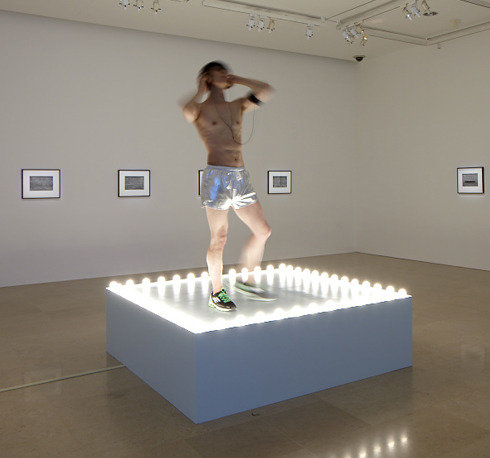Felix Gonzalez-Torres
dal 20/6/2012 al 27/9/2012
Segnalato da
20/6/2012
Felix Gonzalez-Torres
Plateau - Samsung Museum of Art, Seoul
Double. This exhibition examines the broad spectrum of his oeuvre with particular emphasis on the malleable nature of his works, demonstrating how their meaning, as much as the form, can shift as the architectural, social, and curatorial landscapes change.

Curated by Soyeon Ahn, Chief Curator, PLATEAU, Samsung Museum of Art, Korea.
PLATEAU, Samsung Museum of Art is pleased to present a solo exhibition of Felix Gonzalez-Torres, entitled Double. This exhibition examines the broad spectrum of Gonzalez-Torres's oeuvre with particular emphasis on the malleable nature of his works, demonstrating how their meaning, as much as the form, can shift as the architectural, social, and curatorial landscapes change. As suggested in the title, Double proposes a dual presentation at both PLATEAU and our sister museum Leeum, as well as multiple locations throughout the city of Seoul, involving various ways of repetition and reconfiguration of the artist's works. Utilizing editions and simultaneous manifestations of identical pieces, the presentation hopes to reflect the continuing vitality of his art, which continues to inspire countless artists in contemporary art today.
Felix Gonzalez-Torres, who died at the early age of 38 in 1996, is considered one of the most influential artists of his generation whose legacy still remains strongly present in the current art historical discourse. Born in 1957 in Cuba and immigrated to New York City in 1979, the artist did not allow his racial and sexual minority status to marginalize his position in the art world, instead developing his own unique body of work by appropriating the existing visual language of minimalism. At the same time, he actively engaged the viewer in his works, subverting conventional art practices through its endless transformation and destruction of form. Using everyday objects such as mirrors, clocks, puzzles, candies, and paper stacks, Gonzalez-Torres's oeuvre more profoundly examined the "public" function of art, while presenting strictly private contemplations on love and the fragility of life. From the socially critical works of the 1980s to the more contemplative and poetic works of the 1990s, his oeuvre achieved its distinct perspective through the juxtaposition of the private and public, as well as the poetic and political.
Challenging tradition, monumentality and even his own authority as artist, Gonzalez-Torres emphasized the mutability of meaning and form in order to keep his work alive and connected with the viewers across cultures and generations. His works will also have a powerful resonance with Korean viewers today who have undergone dramatic political, economic and cultural changes over the recent decades. As the first comprehensive exhibition of Gonzalez-Torres's work in Asia, this exhibition will provide a significant opportunity to introduce the remarkable achievements of his short but prolific career to the Korean and international audiences in the region.
Born in 1957 in Guaimaro, Cuba, Felix Gonzalez-Torres fled to Madrid in 1970 and moved to Puerto Rico, where he grew up. In 1979, the artist emigrated to New York City, where he received his BFA and MA in photography from the Pratt Institute of Art in 1983 and NYU's International Center of Photography in 1987. In the same year, Gonzalez-Torres joined the artists' collective Group Material and held his first solo exhibition in 1988. In 1992, The Museum of Modern Art, New York, invited Gonzalez-Torres to participate in its Billboard Projects series, followed by a series of solo exhibitions at major art institutions including the Museum of Contemporary Art, Los Angeles and the Hirshhorn Museum and Sculpture Garden. During his lifetime, Gonzalez-Torres participated in over 100 group exhibitions, including the Whitney Biennial (1991), the Venice Biennale (1993), and a touring retrospective at the Solomon R. Guggenheim Museum, New York that proceeded to Spain and Paris.
Even after his early death at age 38 in 1996, Gonzalez-Torres has been included in over 500 exhibitions worldwide, establishing him as one of the most influential artists in contemporary art. In 2007, Gonzalez-Torres became only the second artist to posthumously represent the United States in the history of the Venice Biennale. In 2010-2011, his major traveling exhibition Specific Objects without Specific Form toured across Europe, and the 2011 Istanbul Biennale was held in honor of his artistic achievements.
PLATEAU, Samsung Museum of Art was first inaugurated in 1999 as Rodin Gallery, presenting its permanent installation of Auguste Rodin's monumental masterpieces, The Gates of Hell and The Burghers of Calais, and has established itself as one of the central institutions in the Korean contemporary art scene.
In May 2011, Rodin Gallery reopened its doors under the new name, PLATEAU, aspiring a broader scope of program, as well as higher artistic grounds for artists and patrons alike. With the new name, PLATEAU expresses our renewed commitment to embracing the dynamic developments in Korean and international contemporary art, in continuation with our permanent display of the Rodin masterpieces.
Press contact:
Lee Kyoung Ock, Public Relations Team T +82 2 2014 6552 / kyoungock81.lee@samsung.com
PLATEAU, Samsung Museum of Art
Samsung Life Insurance Building
Taepyeongno2-Ga, Jung-Gu,
Seoul, Korea 100-716
Hours: Tues–Sun, 10–6pm
Admission
Adults 3,000 won
Ages 7-18 2,000 won



